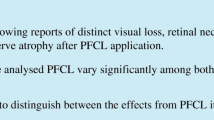Abstract
Background
To investigate the reasons for difficulties removing silicone oil from the vitreous cavity due to putative adherence to the retina.
Methods
Gas chromatography-coupled mass spectroscopy of the headspace (GC/MS/HS) and gel permeation chromatography (GPC) were used to detect volatile compounds in silicone oil samples explanted from patients, qualitatively as well as quantitatively. Surface and interfacial tensions of the explanted samples were measured using the pendent-drop technique. To simulate the removal of silicone oil from the vitreous cavity, the contact between silicone oil and differently treated surfaces and various aspiration techniques were tested in vitro.
Results
The median concentration of perfluorodecalin in seven “sticky” samples was 2.4 times higher than in 14 non-sticky samples. In the sticky samples, the median surface tension of the aqueous phase was lower. The difficulty of aspirating silicone oil could be reproduced in vitro by reducing the surface tension of the aqueous environment of the silicone oil.
Conclusion
The observed stickiness of silicone oil seems to be a matter of reduced surface tension of the surrounding aqueous material and/or contamination of silicone oil with perfluorocarbon liquid, which creates interruption of the material flow, giving the impression of adherence of the silicone oil to the retina.


Similar content being viewed by others
References
Cibis PA, Becker B, Okun E, Canaan S (1962) The use of liquid silicone in retinal detachment surgery. Arch Ophthalmol 68:590–599
Doi M, Ning M, Ida H et al (2000) Histopathologic retinal changes with intravitreous fluorosilicone oil in rabbit eyes. Retina 20(5):532–536
Doi M, Refojo MF (1995) Histopathology of rabbit eyes with silicone-fluorosilicone copolymer oil as six months internal retinal tamponade. Exp Eye Res 61(4):469–478
Dresp JH, Menz D-H (2005) Interaction of different ocular endotamponades as a risk factor for silicone oil emulsification. Retina 25:902–910
Gabel VP, Kampik A, Gabel C, Spiegel D (1987) Silicone oil with high specific gravity for intraocular use. Br J Ophthalmol 71(4):262–267
Giaever I, Keese CR (1983) Behavior of cells at fluid interfaces. Proc Natl Acad Sci USA 80(1):219–222
Gremillion CM Jr, Peyman GA, Liu KR, Naguib KS (1990) Fluorosilicone oil in the treatment of retinal detachment. Br J Ophthalmol 74(11):643–646
Han L, Cairns JD, Campbell WG et al (1998) Use of silicone oil in the treatment of complicated retinal detachment: results from 1981 to 1994. Aust N Z J Ophthalmol 26(4):299–304
Hoerauf H, Faude F, Menz DH, Dresp J, Wiedemann P, Laqua H (2002) Determination of the solubility of perfluorocarbon liquids in silicone oil in vitro and in vivo. Retina 22(2):163–168
Jonas JB, Budde WM, Knorr HL (1999) Timing of retinal detachment after removal of intraocular silicone oil tamponade. Am J Ophthalmol 128(5):628–631
Kampik A, Hoeing C, Heidenkummer HP (1992) Problems and timing in the removal of silicone oil. Retina 12(3):S11–S16
Nakamura K, Refojo MF, Crabtree DV (1990) Factors contributing to the emulsification of intraocular silicone and fluorosilicone oils. Invest Ophthalmol Vis Sci 31:647–656
Peyman GA, Conway MD, Soike KF et al (1991) Long-term vitreous replacement in primates with intravitreal vitreon or vitreon plus silicone oil. Ophthalmic Surg 22:657–664
Peyman GA, Smith RT, Charles H (1987) Injection of fluorosilicone oil and pars plana vitrectomy for complex retinal detachment. Can J Ophthalmol 22(5):276–278
Scholda C, Egger S, Lakits A et al (2000) Retinal detachment after silicone oil removal. Acta Ophthalmol Scand 78(2):182–186
Scholda C, Egger S, Lakits A, Haddad R (1997) Silicone oil removal: results, risks and complications. Acta Ophthalmol Scand 75(6):695–699
Scott JD (1975) The treatment of massive vitreous retraction by the separation of pre-retinal membranes using liquid silicone. Mod Probl Ophthalmol 15:285–290
Sparrow JR, Jayakumar A, Berrocal M et al (1992) Experimental studies of the combined use of vitreous substitutes of high and low specific gravity. Retina 12:134–140
Sparrow JR, Ortiz R, MacLeish PR, Chang S (1990) Fibroblast behavior at aqueous interfaces with perfluorocarbon, silicone, and fluorosilicone liquids. Invest Ophthalmol Vis Sci 31(4):638–646
Stilma JS, Koster R, Zivojnovic R (1986) Radical vitrectomy and silicone oil injection in the treatment of proliferative vitreoretinopathy following retinal detachment. Doc Ophthalmol 64:109–116
Van Meurs JC, Mertens DA, Peperkamp E, Post J (1993) Five-year results of vitrectomy and silicone oil in patients with proliferative vitreoretinopathy. Retina 13(4):285–289
Van Meurs J, Veckeneer M, de Voogd S, Verbruggen M (2003) An “epidemic” of sticky silicone oil at the Rotterdam Eye Hospital. Book of abstracts: first meeting on heavy tamponades in vitreo-retinal surgery (HEA-TAM1). Telfs, Austria
Versura P, Cellini M, Torreggiani A et al (2001) The biocompatibility of silicone, fluorosilicone and perfluorocarbon liquids as vitreous tamponades. An ultrastructural and immunohistochemical study. Ophthalmologica 21(4):276–283
Wiedemann P, Hilgers RD, Bauer P, Heimann K (1998) Adjunctive daunorubicin in the treatment of proliferative vitreoretinopathy: results of a multicenter clinical trial. Daunomycin Study Group. Am J Ophthalmol 126(4):550–559
Winter M, Winter C, Wiechens B (1999) Quantification of intraocular retained perfluorodecalin after macroscopic removal. Graefe’s Arch Clin Exp Ophthalmol 237:153–156
Wolf S, Schoen V, Meier P, Wiedemann P (2003) Silicone oil-RMN3 mixture (“heavy silicone oil”) as internal tamponade for complicated retinal detachment. Retina 23:335–342
Wong D, Williams RL, German MJ (1998) Exchange of perfluorodecalin for gas or oil: a model for avoiding slippage. Graefes Arch Clin Exp Ophthalmol 236(3):234–237
Yamamoto S, Takeuchi S (2000) Silicone oil and fluorosilicone. Semin Ophthalmol 15(1):15–24
Zivojnovic R, Mertens DAE, Peperkamp E (1982) Das flüssige Silikon in der Amotiochirurgie (II). Bericht über 280 Fälle. Weitere Entwicklung der Technik. Klin Monatsbl Augenheilkunde 181:444–452
Author information
Authors and Affiliations
Corresponding author
Additional information
Joachim H. Dresp and Dirk-Henning Menz: Both authors have a proprietary interest in the research described in the present study.
Rights and permissions
About this article
Cite this article
Dresp, J.H., Menz, DH. The phenomenon of “sticky” silicone oil. Graefe's Arch Clin Exp Ophthalmol 245, 863–868 (2007). https://doi.org/10.1007/s00417-006-0450-z
Received:
Revised:
Accepted:
Published:
Issue Date:
DOI: https://doi.org/10.1007/s00417-006-0450-z




